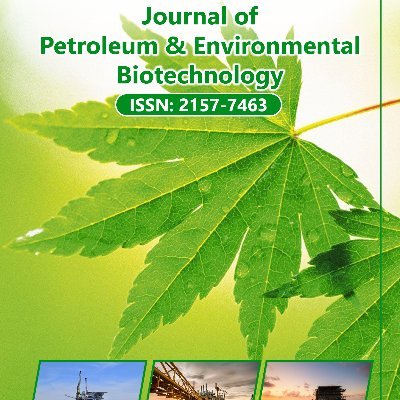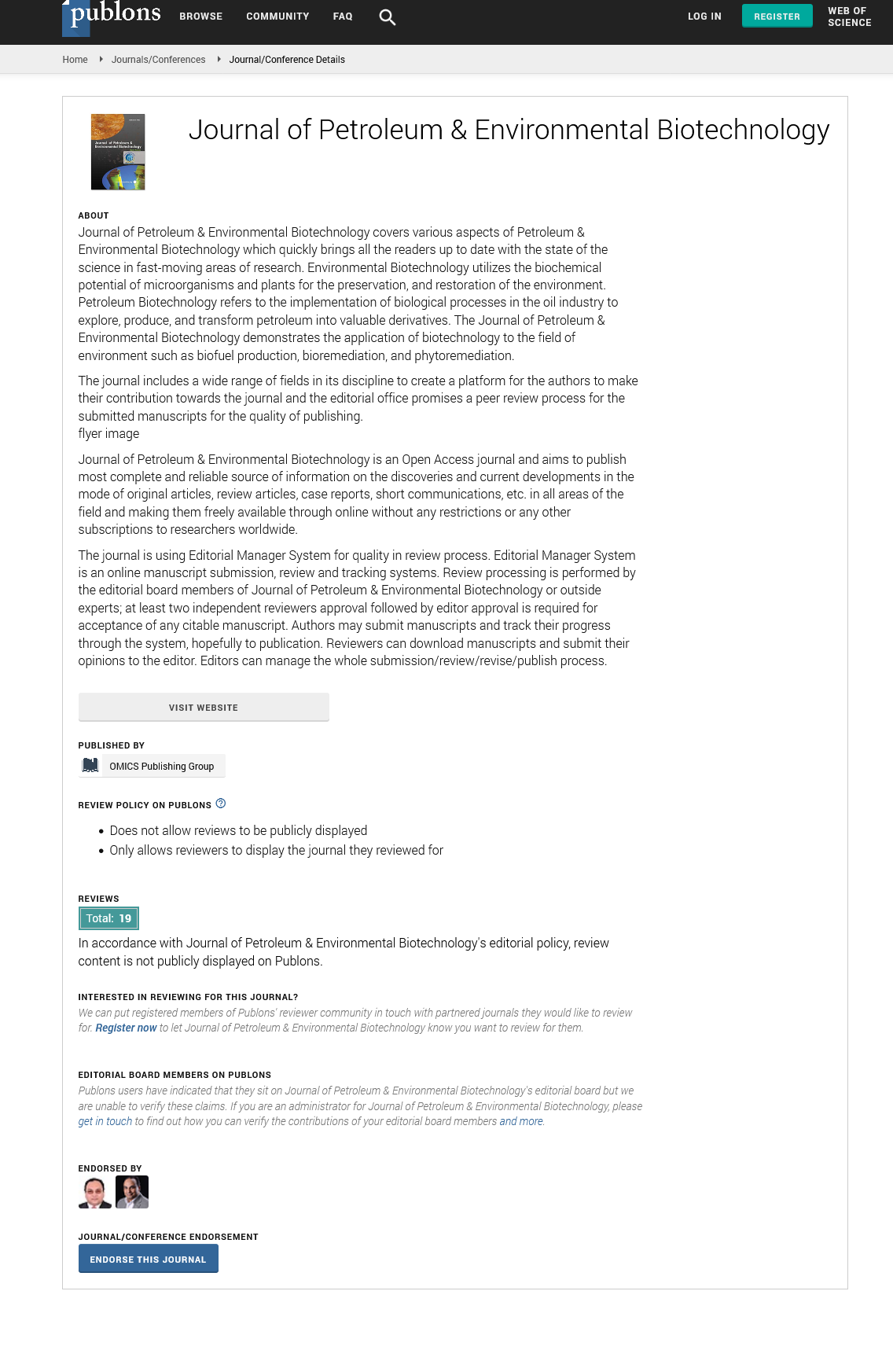Indexed In
- Open J Gate
- Genamics JournalSeek
- JournalTOCs
- China National Knowledge Infrastructure (CNKI)
- Electronic Journals Library
- RefSeek
- Hamdard University
- EBSCO A-Z
- OCLC- WorldCat
- SWB online catalog
- Virtual Library of Biology (vifabio)
- Publons
- MIAR
- Euro Pub
- Google Scholar
Useful Links
Share This Page
Journal Flyer

Open Access Journals
- Agri and Aquaculture
- Biochemistry
- Bioinformatics & Systems Biology
- Business & Management
- Chemistry
- Clinical Sciences
- Engineering
- Food & Nutrition
- General Science
- Genetics & Molecular Biology
- Immunology & Microbiology
- Medical Sciences
- Neuroscience & Psychology
- Nursing & Health Care
- Pharmaceutical Sciences
Commentary - (2024) Volume 15, Issue 2
Innovative Approaches to Environmental Restoration: Microbial Degradation of Petroleum
Zhu Chunyan*Received: 20-May-2024, Manuscript No. JPEB-24-26317; Editor assigned: 22-May-2024, Pre QC No. JPEB-24-26317 (PQ); Reviewed: 05-Jun-2024, QC No. JPEB-24-26317; Revised: 12-Jun-2024, Manuscript No. JPEB-24-26317 (R); Published: 19-Jun-2024, DOI: 10.35248/2157-7463.24.15.571
Description
Microbial degradation of petroleum hydrocarbons represents a remarkable process where microorganisms, through their metabolic activities, break down complex hydrocarbon molecules derived from crude oil. This natural phenomenon plays a vital role in mitigating the environmental impact of oil spills and contamination, offering a sustainable approach to bioremediation. Understanding the mechanisms and factors influencing microbial degradation is important for developing effective strategies to utilize these natural processes for environmental cleanup and conservation.
Petroleum hydrocarbons are organic compounds composed primarily of carbon and hydrogen, found in varying mixtures in crude oil. When released into the environment through accidental spills, leaks, or industrial activities, petroleum hydrocarbons can pose significant ecological risks due to their toxicity and persistence in soil, water, and air. These compounds can adversely affect ecosystems, including terrestrial and aquatic habitats, by contaminating soil, disrupting nutrient cycles, and harming plant and animal life. Microorganisms, including bacteria, archaea, and fungi, have evolved diverse metabolic pathways to degrade and utilize petroleum hydrocarbons as carbon and energy sources. This natural ability forms the basis of microbial biodegradation, a process that occurs under aerobic (oxygen-rich) or anaerobic (oxygen-depleted) conditions, depending on the microbial community and environmental factors. Microbial degradation of petroleum hydrocarbons involves enzymatic processes where specific enzymes catalyze the breakdown of hydrocarbon bonds. For example, hydrocarbon degrading bacteria produce enzymes such as hydroxylases and oxygenases that initiate the oxidation of hydrocarbons, converting them into less complex compounds like alcohols, ketones, and organic acids. These intermediates are further metabolized through sequential enzymatic reactions until they are completely mineralized to carbon dioxide and water.
Factors influencing microbial degradation
Several factors influence the rate and efficiency of microbial degradation in contaminated environments. Temperature, pH, moisture content, and nutrient availability are effective environmental parameters that affect microbial activity and growth. Optimal conditions vary depending on the types of hydrocarbons present and the microbial species involved. Additionally, the composition and concentration of hydrocarbons, as well as the presence of co-contaminants and toxic substances, can either stimulate or inhibit microbial degradation processes.
Applications in bioremediation
The ability of microorganisms to degrade petroleum hydrocarbons has profound implications for environmental bioremediation strategies. Bioremediation harnesses the natural capabilities of microbial communities to accelerate the degradation and removal of contaminants from soil, water, and sediment. In situ bioremediation involves introducing microbial inoculants or enhancing native microbial populations in contaminated sites to facilitate the degradation of petroleum hydrocarbons over time. Ex situ bioremediation techniques, such as bioreactors and land farming, involve excavating contaminated soil or sediment and treating it in controlled environments where optimal conditions for microbial degradation can be maintained. These approaches are often supplemented with nutrients and oxygen to enhance microbial activity and promote efficient hydrocarbon degradation. Bioremediation offers a cost-effective and environmentally sustainable alternative to traditional cleanup methods like excavation and incineration, minimizing disturbance to ecosystems and reducing overall remediation costs.
Numerous case studies demonstrate the efficacy of microbial biodegradation in remediation efforts following oil spills and industrial accidents. For example, after the Deep water Horizon oil spill in the Gulf of Mexico in 2010, microbial communities in the marine environment played an important role in breaking down and dispersing petroleum hydrocarbons. Similarly, microbial bioremediation techniques have been successfully applied in terrestrial environments contaminated by oil spills or leaking storage tanks, restoring soil quality and reducing environmental risks.
Challenges and future directions
Despite its potential, microbial degradation of petroleum hydrocarbons faces several challenges that limit its widespread application. Variability in environmental conditions, microbial diversity, and hydrocarbon composition can influence the success of bioremediation efforts. Moreover, the timeframe required for complete degradation can be prolonged, especially for complex mixtures of hydrocarbons or in environments with limited nutrient availability. Future research directions aim to overcome these challenges through advancements in microbial ecology, genomics, and biotechnology. Understanding the genetic basis of hydrocarbon-degrading enzymes and metabolic pathways in diverse microbial communities can guide the development of genetically engineered microbes with enhanced degradation capabilities. Additionally, integrating bioremediation with complementary technologies, such as nanotechnology and chemical surfactants, provides potential for enhancing the efficiency and applicability of microbial degradation strategies in diverse environmental settings.
Conclusion
Microbial degradation of petroleum hydrocarbons represents a natural and sustainable approach to mitigating environmental contamination and restoring ecosystems impacted by oil spills and industrial activities. By utilizing the metabolic diversity of microorganisms, researchers and environmental practitioners can develop innovative bioremediation strategies that promote the efficient degradation of hydrocarbons in soil, water, and sediment. Continued research and technological advancements are essential for optimizing microbial biodegradation processes and expanding their application in environmental conservation and sustainable development efforts globally. Through collaborative efforts and interdisciplinary approaches, microbial bioremediation offers a potential pathway towards reducing the environmental impacts of petroleum pollution and safeguarding ecosystems for future generations.
Citation: Chunyan Z (2024) Innovative Approaches to Environmental Restoration: Microbial Degradation of Petroleum. J Pet Environ Biotechnol. 15:571.
Copyright: © 2024 Chunyan Z. This is an open access article distributed under the terms of the Creative Commons Attribution License, which permits unrestricted use, distribution, and reproduction in any medium, provided the original author and source are credited.

